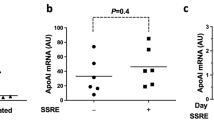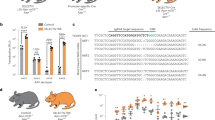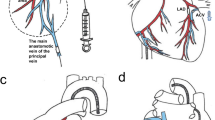Abstract
Recombinant adenoviruses are employed widely for vascular gene transfer. Vascular smooth muscle cells (SMCs) are a relatively poor target for transgene expression after adenovirus-mediated gene delivery, however, even when expression is regulated by powerful, constitutive viral promoters. The major immediate-early murine cytomegalovirus enhancer/promoter (MIEmCMV) elicits substantially greater transgene expression than the human cytomegalovirus promoter (MIEhCMV) in all cell types in which they have been compared. The Woodchuck hepatitis virus post-transcriptional regulatory element (WPRE) increases transgene expression in numerous cell lines, and fragments of the smooth muscle myosin heavy chain (SMMHC) promoter increase expression within SMC from heterologous promoters. We therefore, compared the expression of β-galactosidase after adenovirus-mediated gene transfer of lacZ under the transcriptional regulation of a variety of combinations of the promoters and enhancers described, in vitro and in porcine coronary arteries. We demonstrate that inclusion of WPRE and a fragment of the rabbit SMMHC promoter along with MIEmCMV increases β-galactosidase expression 90-fold in SMC in vitro and ≈40-fold in coronary arteries, compared with vectors in which expression is regulated by MIEhCMV alone. Expression cassette modification represents a simple method of improving adenovirus-mediated vascular gene transfer efficiency and has important implications for the development of efficient cardiovascular gene therapy strategies.
This is a preview of subscription content, access via your institution
Access options
Subscribe to this journal
Receive 12 print issues and online access
$259.00 per year
only $21.58 per issue
Buy this article
- Purchase on Springer Link
- Instant access to full article PDF
Prices may be subject to local taxes which are calculated during checkout






Similar content being viewed by others
References
Laitinen M et al. Gene transfer into the carotid artery using an adventitial collar: comparison of the effectiveness of the plasmid–liposome complexes, retroviruses, pseudotyped retroviruses and adenoviruses. Hum Gene Ther 1997; 8: 1645–1650.
Feldman LJ, Steg G . Optimal techniques for arterial gene transfer. Cardiovasc Res 1997; 35: 391–404.
Wickham TJ et al. Targeted adenovirus gene transfer to endothelial and smooth muscle cells by using bispecific antibodies. J Virol 1996; 70: 6831–6838.
Clesham GJ, Browne H, Efstathiou S, Wiessberg PL . Enhancer stimulation unmasks latent gene transfer after adenovirus-mediated gene delivery into human vascular smooth muscle cells. Circ Res 1996; 79: 1188–1195.
De Young MB et al. Optimizing vascular gene transfer of plasminogen activator inhibitor 1. Hum Gene Ther 1999; 10: 1469–1478.
Kim S et al. Transcriptional targeting of replication-defective adenovirus transgene expression to smooth muscle cells in vivo. J Clin Invest 1997; 100: 1006–1014.
Ribault S et al. Chimeric smooth muscle-specific enhancers/promoters – valuable tools for adenovirus-mediated cardiovascular gene therapy. Circ Res 2001; 88: 468–475.
Addison CL, Hitt M, Kunsken D, Graham FL . Comparison of the human versus murine cytomegalovirus immediate early gene promoters for transgene expression by adenoviral vectors. J Gen Virol 1997; 78: 1653–1661.
Gerdes CA, Castro MG, Lowenstein PR . Strong promoters are the key to highly efficient, noninflammatory and noncytotoxic adenoviral-mediated transgene delivery into the brain in vivo. Mol Ther 2000; 2: 330–338.
Zufferey R, Donello J, Trono D, Hope T . Woodchuck hepatitis virus posttranscriptional regulatory element enhances expression of transgenes delivered by retroviral vectors. J Virol 1999; 73: 2886–2892.
Kallmeier RC, Somasundaram C, Babij P . A novel smooth muscle-specific enhancer regulates transcription of the smooth muscle myosin heavy chain gene in vascular smooth muscle cells. J Biol Chem 1995; 270: 30949–30957.
Watanabe M et al. Structure and characterization of the 5′-flanking region of the mouse smooth muscle myosin heavy chain (SM1/2) gene. Circ Res 1996; 78: 978–989.
Kingston PA et al. The murine cytomegalovirus immediate early enhancer/promoter is a more potent regulator of transgene expression than the human promoter in vascular smooth muscle cells in vitro. J Am Coll Cardiol 2001; 37(Suppl A): 266A(Abstract).
Li G et al. Direct in vivo evidence demonstrating neointimal migration of adventitial fibroblasts after balloon injury of rat carotid arteries. Circulation 2000; 101: 1362–1365.
Madsen CS et al. Expression of the smooth muscle myosin heavy chain gene is regulated by a negative-acting GC-rich element located between two positive-acting serum response factor-binding elements. J Biol Chem 1997; 272: 6332–6340.
Akyurek LM et al. SM22α promoter targets gene expression to vascular smooth muscle cells in vitro and in vivo. Mol Med 2000; 6: 983–991.
Wickham TJ et al. Increased in vitro and in vivo gene transfer by adenovirus vectors containing chimeric fibre proteins. J Virol 1997; 71: 8221–8229.
Su E et al. A genetically modified adenoviral vector that exhibits enhanced gene transfer of human smooth muscle cells. J Vasc Res 2001; 38: 471–478.
Havenga M et al. Improved adenoviral vectors for infection into cardiovascular tissues. J Virol 2001; 75: 3335–3342.
Kingston PA et al. Adenovirus-mediated transfer of a secreted transforming growth factor-beta type II receptor inhibits luminal loss and constrictive remodelling after coronary angioplasty and enhances adventitial collagen deposition. Circulation 2001; 104: 2595–2601.
Southgate TD et al. Transcriptional targeting to the anterior pituitary lactotrophic cells using recombinant adenovirus vectors in vitro and in vivo in normal and estrogen/sulphiride-induced hyperplastic anterior pituitaries. Endocrinology 2000; 141: 3493–3505.
Southgate TD, Kingston PA, Castro MG . Gene transfer into neural cells in vitro using adenoviral vectors. In: Crawley JN et al (eds). Current Protocols in Neuroscience (Suppl 13). New York, NY: John Wiley and Sons, Inc., 2000; pp 4.23.1–4.23.40.
MacGregor GR . Use of E.coli lacZ (β-galactosidase) as a reporter gene. In: Murray EJ (ed). Methods in Molecular Biology, Vol 7: Gene Transfer and Expression Protocols. Clifton, NJ: The Humana Press Inc., 1991, pp 217–235.
Acknowledgements
CEA is a British Heart Foundation Junior Research Fellow (FS/2000072).
Author information
Authors and Affiliations
Rights and permissions
About this article
Cite this article
Appleby, C., Kingston, P., David, A. et al. A novel combination of promoter and enhancers increases transgene expression in vascular smooth muscle cells in vitro and coronary arteries in vivo after adenovirus-mediated gene transfer. Gene Ther 10, 1616–1622 (2003). https://doi.org/10.1038/sj.gt.3302044
Received:
Accepted:
Published:
Issue Date:
DOI: https://doi.org/10.1038/sj.gt.3302044
Keywords
This article is cited by
-
Adenovirus-mediated gene transfer of fibromodulin inhibits neointimal hyperplasia in an organ culture model of human saphenous vein graft disease
Gene Therapy (2009)
-
Endothelial-targeted Gene Transfer of Hypoxia-inducible Factor-1α Augments Ischemic Neovascularization Following Systemic Administration
Molecular Therapy (2008)



